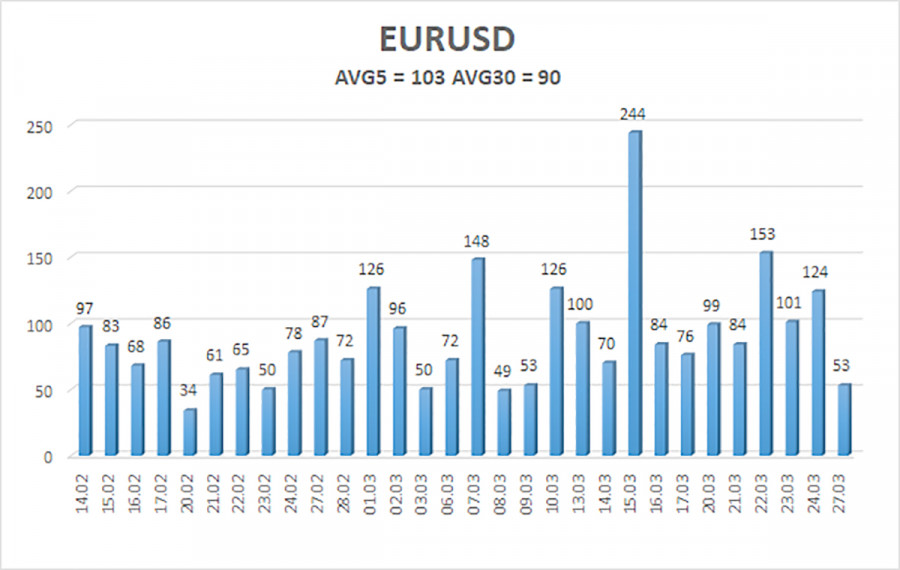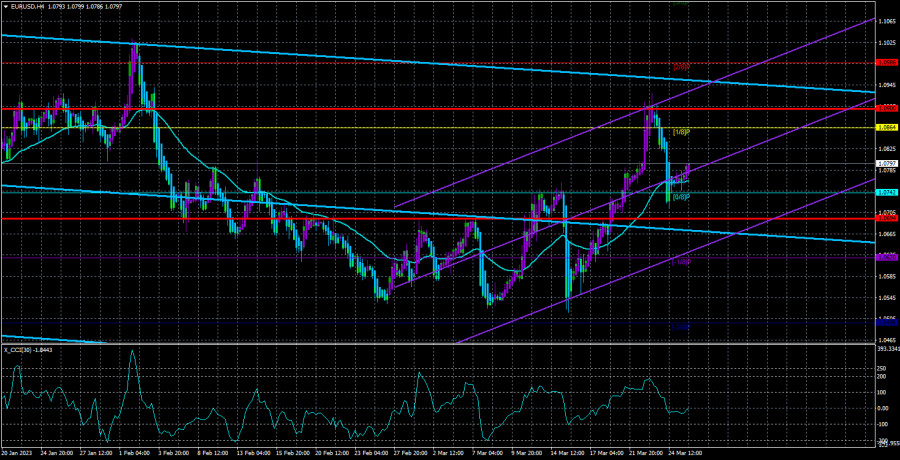On Monday, EUR/USD spiked but failed to break through the moving average. This movement can be explained from the technical point of view – if there is no break through the MA, there is no fall. In terms of fundamentals, growth in EUR on Monday looked strange as there were no drivers for that. Anyway, technical factors are quite enough for trading. Moreover, there will be no fundamentals this week, and the macroeconomic calendar will be almost empty. Thus, the bull run goes on. It could be due to market expectations about interest rates, which rose three weeks ago when three American banks collapsed and the Fed introduced a new $300 billion emergency program. This was when the market realized that the money supply in the US would expand again, which comes contrary to the regulator's intention to tame inflation. However, the Fed simply had no choice, and traders decided it was the perfect moment to sell the greenback.
In the 24-hour time frame, the pair is still near the key Ichimoku lines, which illustrates the absence of a trend movement. We still believe that a bearish correction was too weak, and the pair quickly resumed the uptrend. Let's say the ECB raises rates significantly this year. How far will rates go? The Fed will highly likely lift rates noticeably. The ECB says its rates have not peaked yet, which means that could soon happen. Therefore, we will hardly see a steep rise shortly. In other words, EUR will unlikely strengthen much.
On Friday, Christine Lagarde delivered her fourth or fifth speech in a week. According to the ECB president, core inflation in the EU shows no signs of a slowdown. Each new report logs acceleration. Meanwhile, headline inflation goes down. However, the regulator is guided by core figures when deciding on monetary policy anyway. At this point, one thing is clear – core inflation is high throughout the tightening cycle. Consequently, the bank needs to stay aggressive. In addition, Lagarde said that future rates would depend on incoming data. Her words could be interpreted as a hint at further rate increases, but the president reassured that the ECB might either stay aggressive or pause tightening.
In other words, the central bank will analyze all incoming macro reports carefully, and not just inflation. Let's say all future GDP statistics disappoint. In such a case, the ECB would probably pause tightening. Consequently, rate hikes depend not only on inflation but also on economic growth. A recession in the EU is looming. The economy hardly shows any quarterly growth. A deep recession might be avoided, but there would still be a recession anyway. In other words, each new aggressive move would be a step closer to a recession. Therefore, the ECB will be extremely cautious in the future and will not raise rates by 0.50%. In the meantime, the market expects aggressive measures from the ECB rather than from the Fed. Therefore, there are reasons to buy EUR/USD although they are not sufficient enough after a 1,500-pip increase in value in a matter of months.

On March 28, the 5-day volatility of EUR/USD is 103 pips and is seen as high. The pair is likely to move in the range between 1.0694 and 1.0900 on Tuesday. Heiken Ashi's downward reversal is likely to indicate the start of a downtrend.
Support:
S1 – 1.0742
S2 – 1.0620
S3 – 1.0498
Resistance:
R1 – 1.0864
R2 – 1.0986
R3 – 1.1108
Outlook:
There are attempts to push EUR/USD higher. We buy with targets at 1.0864 and 1.0900 until Heiken Ashi's reversal and sell after consolidation below the moving average, targeting 1.0694 and 1.0620.
Indicators on charts:
Linear Regression Channels help identify the current trend. If both channels move in the same direction, a trend is strong.
Moving Average (20-day, smoothed) defines the short-term and current trends.
Murray levels are target levels for trends and corrections.
Volatility levels (red lines) reflect a possible price channel the pair is likely to trade in within the day based on the current volatility indicators.
CCI indicator. When the indicator is in the oversold zone (below 250) or in the overbought area (above 250), it means that a trend reversal is likely to occur soon.












